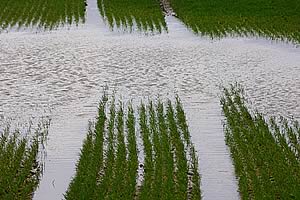 |
|||||||||
|
|||||||||||||||||||
|
|
Reducing Flooding the Natural Way 12/06/08 The key to long-term, cost effective flood prevention could be held in England's National Parks and farmland landscapes, says Natural England today (Thursday 12 June) one year on from last year’s summer floods.
Thriving wetlands, restored peat bogs and free-flowing rivers are recommended by Natural England to reduce the harmful effects of flooding. By increasing the natural capacity of the countryside to absorb and hold excess water, we can help to slow run-off and dramatically decrease the risk of flooding. Sir Martin Doughty, Chair of Natural England, said: “Natural flood defences could be the key to long-term flood prevention. Well-managed landscapes not only play a crucial role in our need to cope with the increased probability of extreme rainfall, but they have huge potential benefits for biodiversity, pollution reduction and carbon storage. “The capacity of the countryside to absorb water must be increased. To do this we must start by reversing changes made to landscapes. Restoration of peat bogs in the uplands would slow water reaching the streams and lowland rivers, reducing the threat to towns such as Ripon, Hull and Sheffield – all of which have experienced severe flooding. “‘Flood friendly’ land management is not a replacement for, but a necessary complement to existing flood defence. Traditional flood defences of concrete and earth embankments may no longer be adequate or sustainable in the long-term,” concluded Sir Martin. Restoration of peat bogs: the uplands of the Pennines, such as those above Sheffield, are criss-crossed by over 30,000km of moor grips most of which were funded by Government grants in the 1970’s and 1980’s. Rainfall which used to be absorbed by peat bogs, rushes through these moorland drains into streams and lowland rivers, threatening the towns on their banks. The floods which occurred in Ripon in 2000 - and again in June 2007 - are a case in point. Restoration of these peat bogs will not only benefit precious wildlife habitat, but also reduce run-off. Natural England with partners at the Peak District National Park and United Utilities have been working on a variety of initiatives across the North Pennines and the Bowland Fells to get this work moving. The other benefit of restoring these habitats is sheer quantities of carbon that they store: there is more carbon stored in the UK’s peat than in all the forests of Britain and France combined. All of the peatlands in England and Wales would absorb around 41,000 tonnes of carbon a year if in a pristine condition but could emit up to 381,000 tonnes of carbon a year if they are damaged by practices such as excessive burning, drainage and over-grazing. The restoration and enhancement of peatlands could save around 400,000 tonnes a year, which is equivalent to the greenhouse gas emissions from 1.1 billion car miles or 84,000 family-sized cars. Recreation of wetlands: Natural England is a partner in the 50-year Wetland Vision project, which is seeking to recreate floodplain wetland habitats - not just washlands - in suitable localities. An example is the Great Fen project, intended to link two National Nature Reserves (Holme Fen and Woodwalton Fen) south of Peterborough. This will also contribute to the new UK Biodiversity Action Plan (BAP) target to create 8 landscape-scale wetland complexes, and add to the flood storage capacity in the Middle Level. Free-flowing rivers: removal of in-channel structures from rivers has multiple benefits. The River Wensum, a European Special Area of Conservation (SAC) in Norfolk, where the removal or lowering of three redundant mill weirs is seen as the most cost-effective solution to flooding problems in the upstream villages. This is also a key step in a river restoration plan for the River Wensum SAC, 67% of which is backed up from such structures. This is the first whole-river restoration strategy in England. It is led by Natural England, in partnership with the Environment Agency and the Norfolk Rivers IDB. It has synergies not only with the flood-management strategy, but also with the Fisheries Action Plan and the Wensum Catchment Sensitive Farming (CSF) project.
|
||||||||||||||||||

|
|
||||||||||||||||||
| home | agri-services | pedigree
pen | news | dairy | beef | machinery property | organisations | site map |
|||||||||||||||||||

